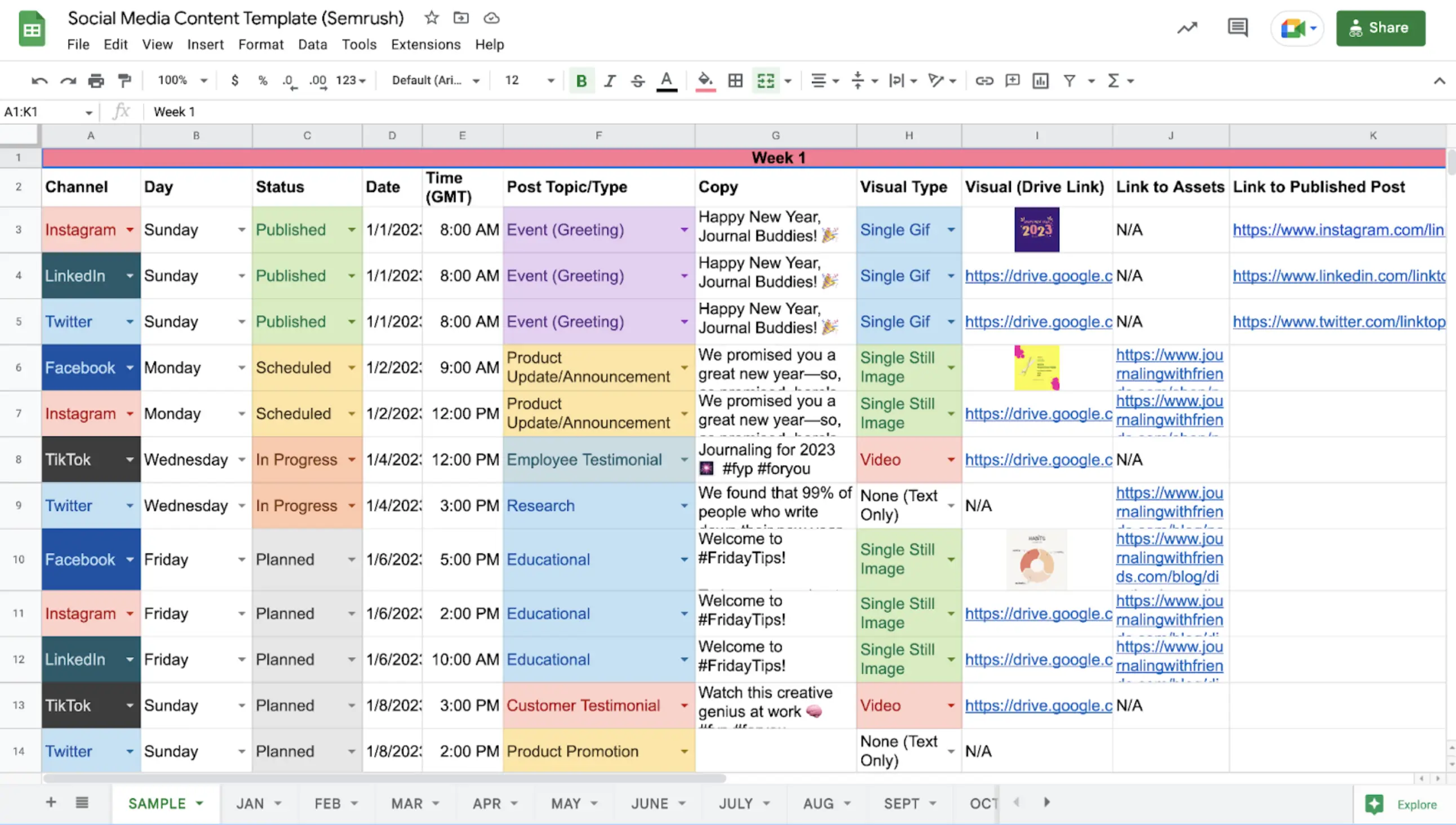Social media positioning is the process of shaping how people perceive your brand on social media. The goal is to distinguish yourself from your rivals.
So, social media positioning involves crafting a unique brand identity, developing a consistent voice, and effectively communicating key messages to engage and connect with users.
To position your brand on social media effectively, however, you need to follow best practices. Follow these tips to get consumers to see you the way you want them to on social media.
Skip to:
- Choose the Right Platforms
- Create and Share High-Quality Content
- Respond to Audience Comments
- Create or Participate in Online Communities

1. Choose the Right Platforms
Not all social media channels are the same. Each channel attracts different types of users. For example, certain social channels tend to attract more male or female users.
According to statistics, YouTube, LinkedIn, Twitter, and TikTok are more popular among men than women. On the other hand, Facebook and Instagram have a higher number of female users.
Pinterest, in particular, is dominated by a female audience. The following are the percentages for each:

Then there’s the fact that each social media platform attracts users with distinct interests. For instance, those who prefer visual content typically frequent Instagram.
Social media users who prefer to read small snippets of text go to Twitter (X) instead. Therefore, it is critical for you to research and identify which social platforms your target audience is most active on.
That will help you tailor your social media strategy and allocate resources to the platforms yielding the highest awareness, engagement, and reach.
With a strong social presence on that platform, the right people–your potential customers–will be exposed to the specific ways you want your brand to be perceived.
So, consider the age range, gender, location, and interests of your target audience. You can discover these characteristics by analyzing the insights provided by the social media platform itself.
These Instagram analytics, for instance, provide information on your audience's median age, gender, and time zone of activity.

Conducting surveys or polls can also be valuable for collecting audience-specific information. The nature of your business can also guide your platform selection.
For example, if you’re a small and medium enterprise, Facebook may be an excellent option, with its over two billion monthly users and excellent engagement features.
No wonder a staggering 93% of SMBs use the channel as a Facebook marketing tool.
Meanwhile, LinkedIn may be more appropriate for professional, enterprise SaaS, and B2B, with its over 63 million companies listed on the platform and over 985 million users that include business decision-makers.
2. Create and Share High-Quality Content
Consistency in creating and sharing high-quality and compelling content is key. With this strategy, you won’t just get new followers on Instagram, comments on Facebook, or LinkedIn shares.
You can also position your brand as one that values quality, not just in its products, but also in everything else.
But don’t just create or share any valuable content on social media. You need to ensure the content you share and create aligns with how you want your brand to be perceived in the first place.
If you're a restaurant owner, understanding restaurant industry statistics is crucial to incorporating and giving a better customer experience.
For instance, if you want to be perceived as a serious brand with authority, then you could post formal-looking infographics about niche trends, for example.
Or if you want people to perceive you as a quirky brand, then post your pics with colorful visuals and light topics. See this example from Skittles (it’s not a small business, but we can still learn from big brands like it):

If you don’t know how you want people to see you in the first place, just create a brand positioning statement and use it as a guide. Once you’ve determined your social media positioning, just stick to it.
The consistency should be seen across all your social media platforms. So, don’t use formal language in your Facebook posts, then share an Instagram Reel of a cute dog with funny captions.
You’ll only end up with a confused audience who doesn’t know what you stand for.
To know what types of content to create and share on social media, you can go back to your audience persona. Look at their preferences and interests.
As a tip, it’s a good idea to create and share a mix of different types of content.
Sharing content is easy. But what about creating content? If that sounds like a lot of work, well, it is. The good news is, we now live in this age of technology.
You can easily scale your content creation with a generative AI platform. For example, tools like the AI paragraph creator help you generate human-like content in a short time. You can also ensure the quality of your output.
Here’s another idea. Why not implement content repurposing techniques to save time in content creation?
Take your existing content types that align with your social media positioning and just tweak them to fit your different platforms.
So, you might turn blog posts into infographics, create short videos from longer webinars, or summarize key points from a podcast into a series of social media posts.
You can also use digital signage layout templates to visually present branded content across screens in a way that reinforces your social identity while saving time on design.
To ensure your social media content doesn’t look repetitive, you can create a content calendar.
The calendar can help you plan and organize your types of content in advance, ensuring a consistent and cohesive content strategy. Here’s a sample spreadsheet calendar.

You can also use paid services like Hootsuite or Buffer to schedule social posts ahead of time.
3. Respond to Audience Comments
Engaging with your audience on social media accounts allows you to position your brand as a customer-centric brand. It also helps you humanize your brand, making it more relatable in the eyes of your potential customers.
As a result, consumer loyalty, word-of-mouth referrals, and overall good brand impressions improve. So, actively respond to comments, messages, and mentions from your followers.
When you promptly address their concerns, answer their questions, and acknowledge their feedback, you show that you value their opinions and are committed to providing excellent customer service.
If you respond to something as seemingly trivial as a “hello” directed at you, you also show how important it is for you to simply connect with your audience.
See how Burt's Bees takes the time to respond to each of its followers’ comments on its post.

You can also respond to comments that aren’t made on your own post. Use social listening tools to look for these other posts that mention your brand or your products so you can respond to these.
4. Create or Participate in Online Communities
Online communities allow you to expand your network, stay updated on industry trends, and foster meaningful connections. But at the same time, they can help you reinforce your social media positioning.
Remember, the more people you reach with your curated social media image, the better. The more people will associate your brand with the values and personality you want them to associate you with in the first place.
To scale your outreach process, you can use tools like Waalaxy or similar. Be sure to compare features and pricing to maximize your efficiency and reach.
For this to happen, though, you’ll need to be consistent with your social media brand image when engaging with members of these online communities.
So, whether it’s a Facebook or LinkedIn group you’re joining, engage with members in such a way your brand personality shines through.
If you’re a fun brand, use casual language full of emoticons when talking to fellow members.
If you’re a more formal brand that wants to be perceived as a go-to source of relevant niche information, then posts like the one below are your best bet:

Whatever the type of social media image you want to reinforce, make sure you proofread your post before hitting that Send button. Grammar issues and spelling mistakes will only tarnish your brand reputation.
In Closing
Mastering effective social media positioning is essential for brands to impact customer impressions. It allows brands to differentiate themselves and create a unique identity that resonates with their target audience.
However, you need to follow tips to ensure effective social media positioning. As discussed, do the following to ensure an effective social media positioning strategy:
- Select the appropriate platforms
- Create and share high-quality content
- Respond to audience comments
- Create or join online communities.
When implementing these tips, ensure consistency in your brand voice and personality. Remember, your goal is for your audience to associate your brand with your chosen values and emotions.
You can only do this if you bombard them with the same imagery and language when they interact with your brand. Do all this right and you’ll be perceived by your audience the way you want them to.
With a strong brand reputation as a result of your excellent social media positioning, you’ll build customer trust, and ultimately drive sales.
Author Bio
Harry Flynn leads the digital marketing team at Twicsy, a site providing services to Instagram users. He enjoys travelling and relaxing with friends in his spare time.



